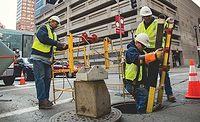Protecting lone security workers

Image via Unsplash
Security workers, regardless of where they are working, face occupational safety hazards like no other industry. These are the quiet people who are around public spaces and services, making sure people are safe.
While performing this important work, these people can face injury when dealing with violent members of the public, dangers slips and falls, toxic substances and gases, as well as the psychological stress of dealing with these hazards. However, security employees are at higher risk of these hazards when they work alone, remotely and/or in isolation.
Who is considered a lone security worker?
A lone worker is a person who performs their job and tasks for a period of time in which emergency help is not readily available should they need it. This includes working without any coworkers or people nearby such as patrolling an empty building, but also includes working in areas where cell reception and communication is a challenge. It also includes monitoring spaces like supermarkets, retail locations, airports, schools and industrial buildings.
According to the International Security Ligue, the non-fatal injury rate for security officers was 14 per 1,000 full-time employees in 2017 with workers in armored cars at 36 for every thousand people; in an 11-year study, researchers also found that hospital security officers’ injury rate was 13 times higher than nursing staff. And in 2009, the US Bureau of Labor Statistics reported that security work is a high-risk job and security officers suffered 63 fatal work injuries and nearly 9,000 non-fatal injuries that required at least one day off.
How to protect lone security workers
These are startling numbers, especially because part of these worker’s jobs is to help protect people, property, public facilities and infrastructure. Even though security leaders can’t predict future incidents and emergencies, there are proactive safety measures that can be taken now to protect security workers down the road.
Conduct hazard assessment: Conducting a thorough hazard assessment which identifies all of the occupational health and safety hazards in a work environment. A hazard assessment determines the dangers, documents them and allows the employer to then look at strategies to mitigate each hazard.
Working alone policy: Developing a "Working Alone" policy to promote consistency in occupational health and safety (OHS) practice should be considered. The policy should cover protocols, procedures and required personal protective equipment (PPE) for working alone, as well as potential hazards and steps to handle them. Proper training and education on the working alone policy for all affected team members is crucial for ensuring their safety, and for enabling them to make informed decisions about their own safety at work.
Safety check-ins: A very simple and effective safety measure for lone workers is safety check-ins to confirm the employee’s well-being. At predetermined times and intervals, the employee will check in with their employer to let them know they are safe. This can be done manually on a whiteboard or phone call, or it can be accomplished using an automated safety system that will prompt the worker to check in and notify emergency contacts when a check-in is missed.
Work in teams: This may appear obvious, however, for employees classified as lone workers, managers need to look at opportunities where they can schedule a coworker to same worksite or coordinate high-risk tasks so that at least two people are present.
Panic button devices: If they find themselves in a situation where they are alone and their safety is at risk, security officers should be equipped with a panic button device that will quickly and discreetly request immediate help. Some industries, like hotel and hospitality, are requiring the provision of panic buttons with their staff who work alone.
Psychological support and services: Due to the emotional stress they may experience, employers also need to provide licensed psychological support for their team members. This includes proactive mental health (showing the employee how to deal with situations before they occur) and reactive counselling (if they have been assaulted or experienced trauma at work).
Accurate location tracking: In the event that a security employee needs urgent help, the first and most important piece of information required to begin the emergency response is the location of the person. Especially when patrolling large buildings and areas, it can be very difficult to locate the employee. There are a number of location-monitoring devices and technological options available, including GPS and satellite devices for security workers in remote areas where cellular service is spotty if accessible at all.
Strong communication: As outlined with the safety check-ins mentioned earlier, it is important for lone workers to regularly communicate with their employer or monitor when working alone. No matter what the channel is, strong communication is key to the lone worker’s safety, providing important information and details that could be imperative to a successful emergency response or rescue.
Address safety now: Conducting an assessment of occupational safety hazards will help security leaders identify the threats and have more control over the work environment and circumstances.
This article originally ran in Security, a twice-monthly security-focused eNewsletter for security end users, brought to you by Security magazine. Subscribe here.
Looking for a reprint of this article?
From high-res PDFs to custom plaques, order your copy today!







